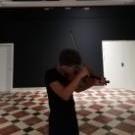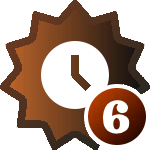
Willibald
Members-
Posts
170 -
Joined
-
Last visited
-
Days Won
11
Willibald last won the day on July 14 2024
Willibald had the most liked content!
About Willibald

Profile Information
-
Gender
Male
-
Location
Austria
-
Favorite Composers
Georg Philipp Telemann, Joseph Haydn
-
Notation Software/Sequencers
ABC, Lilypond, Musescore
-
Instruments Played
Guitar, Piano
Recent Profile Visitors
2,012 profile views
Willibald's Achievements
-
This crab tastes very good. 😉 Really pleasant to listen to, especially as it is short enough that e.g. the steady staccato still doesn't exhaust the listener. Just one comment: It is your composition, so you can certainly do as you see fit, but many textbooks advise against realising a basso continuo as a piano reduction of the score. It is more about harmony than melody. This should help to avoid the wide intervals you mentioned.
- 5 replies
-
- 1
-

-
- counterpoint
- canon cancrizans
-
(and 2 more)
Tagged with:
-
Trio Sonata in g minor for Alto Recorder, Violin and Continuo
Willibald replied to Willibald's topic in Chamber Music
Thanks a lot for your kind words! Indeed, the 2nd movement is my favourite movement as well. Thanks also for your comment regarding variety; this is an area I have to think more about. I wanted to avoid duplicating my trio sonata in C Major (Trio Sonata in C Major), and also to avoid repeating a section. But now, the second half mirrors the first one: Both slow movements are 24 measures long and are structured as A - B - A' (not as clear in the 3rd movement, but still). The fast movements are both fugues with about fifty measures that touch the usual keys. There are differences, for sure, and one could claim it's all on purpose. What I hope for is that as all four movements are rather short, the similarities are not too bothersome. -
Like many trio sonatas, this work consists of four movements: slow - fast - slow - fast. It starts with a three-partite Grave with a slight hint of French ouvertures, though then developing in a different direction. The second movement is a fugue. I am rather fond of a moment where all voices stop and the recorder and violin start the conversation of voices anew, and more lucid than before. The third movement is a through-composed Adagio, followed by a fugal finale in 12/8. This trio sonata is written for alto recorder, violin, cello and harpsichord, but a variety of instruments would fit too, though it leads to interesting changes in the character of the individual movements. I am not sure if the Grave and the Adagio shouldn't be swapped to increase the coherence of the music. Any suggestions welcome.
-
I took up your suggestion, @PeterthePapercomPoser, and produced four new mp3s.
-
Thanks for your feedback! Yes, one problem of my renditions is that they simply reflect the score (except for the added basso continuo realization), but a baroque score leaves plenty of room for the musicians to add ornaments, articulations, etc.. So no musician would play it like it sounds in the mp3. But I will try to improve the score that the audio file is based on for a more realistic feel.
-
I liked it very much. Indeed, I listened a few times. Just two things: The Adagio part shifts in m. 20 to a rhythm similar to a 6/4 time signature. Have you tried simplifying the score by switching the time signature? And the change from the Adagio to the refrain is really abrupt. One possibility to connect two parts is to have a dominant - tonic relationship between the end of one part and the beginning of the other. Funnily enough, I hear the form different than @Rich: Refrain m. 1-6, first couplet m. 6-15; refrain m.16-m.19; second couplet m.20-32; third refrain m33-40. More like ritornello form: a - b - a' - c - a''.
-
Thanks for sharing! Like @Nicholas Schuman, I listened a few times to it as it is so pleasant and engaging. Would be nice if you would pair it with a quick lively movement if you ever feel like it.
-
Very dramatic piece with nice twists. Bar 43 and following could have been cliché, but worked out well. Just two comments: What @Luis Hernández said; I just think it because of a different reason: In a typical fugue, you have blocs with the soggetto and episodes in between, often a bit formulaic, but they provide on one hand relief after the rigorous entries of the soggetto, and on the other hand creates tension: When will the next entry arrive? Your episodes are rather eventful and densely packed. Sometimes, it is ok to take some predictable phrases and be a bit formulaic to provide contrast. And the final cadence is an interesting experiment, I just think for many listeners it wont sound like it really closes the piece. In bar 70, you start with a g minor chord over a tonic pedal (plus a resolution of a 4 to a 3), changing to a D Major chord (f# + a over the pedal), which will invariably sound like the dominant chord for g, especially as you use a g - f# - g, a typical cantizans. Briefly, something like a diminished c# chord emerges, but you could probably make it all clearer by using f instead of f# in measure 70, and just touch f# in the last bar.
-
Fugue in E minor for String Quartet.
Willibald replied to Fugax Contrapunctus's topic in Chamber Music
This was really fun to listen to! The soggetto is very easy to remember and to spot which is very helpful in hearing the structure of the fugue. The texture is well designed, with parts frequently dropping out so that it becomes especially meaningful to the listener when a voice comes back. A litte bit less conversation of the soggetto and a litte bit more episodic action could increase variety in the piece if so desired. Thanks for sharing! -
Willibald started following Trio Sonata in C Major
-
This is a trio sonata inspired by Corelli, Telemann and others, featuring an alto recorder, a violin and a basso continuo group consisting of a cello and a cembalo. It follows a rather standard model, opening with a slow introductory movement full of dissonances, followed by a lively fugue-like movement, contrasted by an adagio in a minor and triple meter, and concluded by a gigue-like joyous finale. Nonetheless, it is quite short, around 5 1/2 minutes, which is in line with many early trio sonatas. One reason for this: There are no repeat signs anywhere. For updated audio files, see my post further down.
-
A really charming, at times very dramatic piece. Under five minutes, but a lot of things are happening. So many ideas! At around 1:20, this scale run comes a bit abrupt for me, but it works probably better in a live performance. At times though, I wonder if the piece would have even more coherence if you would work with less motives but took more time developing them (like you do e.g. with the opening motive). But that is a matter of taste, no criticism.
-
@panta rei Thank you for your suggestions. And I'll probably also change the notation. The suspended leading tone resolving upwards to the tonic is found in compositions of the young Haydn or in Gluck's works etc.; however, usually notated as an appogiatura which I will do as well.
-
It is really nice how one core idea and three instruments are enough for this colourful and joyous piece.The ending, however, is really surprising, as the voices don't follow usual cadential formulas. Bassizans in the flute, the bassoon probably some sort of cantizans, and the guitar an altizans. The penultimate chord is the dominant of a minor (?), jumping right into A Major. That's witty and adds a bit of Renaissance flair, but works only because flute and bassoon provide the necessary duration of the final chord which otherwise wouldn't be heard as final (I assume) because of the voice leading. Regarding 12/8 and 9/8: I am not sure it really feels like a change in rhythm; overall, the 3/8-units provide the basic pattern. If you would notate it with 3/8, probably there wouldn't be much of a difference for most listeners. Thanks for sharing!
-
Keyboard Suite in F major (complete) - M. Li
Willibald replied to muchen_'s topic in Piano Music, Solo Keyboard
I am very impressed by this opus magnum. Highly varied, stylistically coherent, and really engaging. So, take my few criticisms as more or less fine-tuning suggestions. As you write, the choice of musical form for some dance movements is unusual for a Bachian suite, e.g. an Allemande as chorale fantasia etc., or the pairing "Scherzo - Trio", which was introduced by Joseph Haydn. Also, Bach usually inserted extra movements between Sarabande and Gigue, not between Courante and Sarabande. But it's your suite, not Bach's 😉 The Overture is marvelous, the fugato could be a bit more lively, but is overall very nice. Some passages seem rather difficult to play, e.g. large intervals between voices in the right hand, which can be remedied frequently by putting the alto voice in some instances in the left hand. The contrast between the slow Allemande and the lively Courante could be stronger; their pulse is more similar than one would expect. The Gigue is a perfect final movement and really joyful. Employing the Baroque device of using the opening subject in (partial) inversion in the second half gives it a very authentic touch. Thanks for sharing your composition! -
@Luis Hernández Thank you for your clarification. I thought of this as a rather idiomatic phrase but will definitively check it again.







